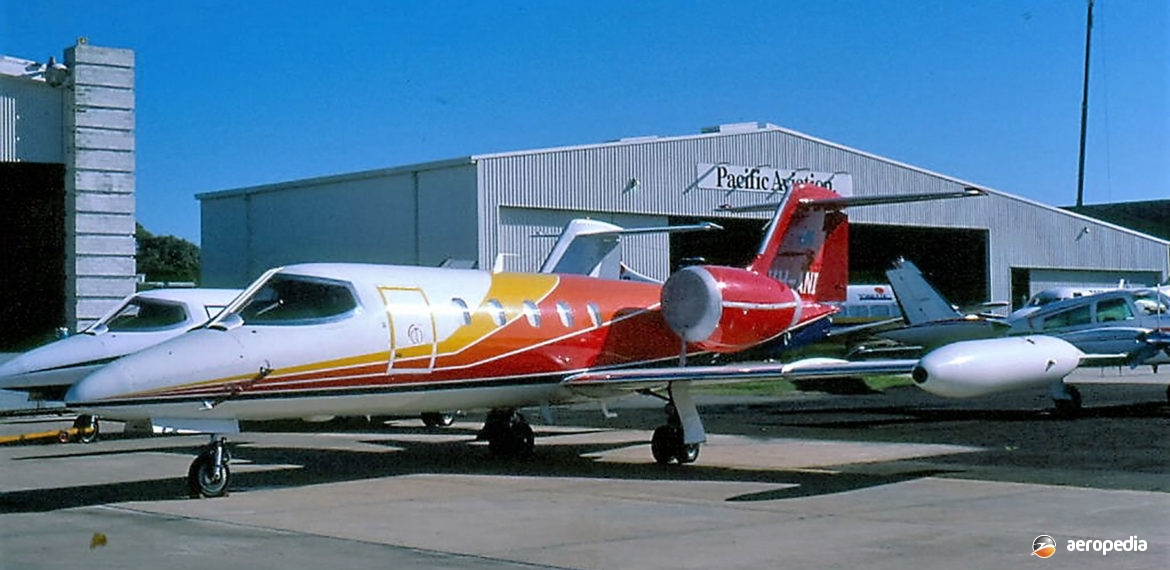Photograph:
Learjet 35A VH-ANI (c/n 468) at Mascot, NSW in May 1985 (David C Eyre)
Country of origin:
United States of America
Description:
Business and executive aircraft
Power Plant:
Two 3,500 lbst Garrett AiResearch TPE 731-2 turbofans
Specifications:
- Wingspan: 12.04 m (39 ft 6 in)
- Length: 14.83 m (48 ft 8 in)
- Height: 3.73 m (12 ft 3 in)
- Wing area: 23.53 m² (253.3 sq ft)
- Max cruising speed: 859 km/h (534 mph)
- Economical cruising speed: 774 km/h (481 mph)
- Initial rate of climb: 1,554 m/min (5,100 ft/min)
- Service ceiling: 12,955 m (42,500 ft)
- Range with four passengers, max fuel and reserves: 4,466 km (2,775 miles)
- Empty weight: 4,132 kg (9,110 lb)
- Max payload: 1,810 kg (3,990 lb)
- Loaded weight: 7,711 kg (17,000 lb)
History:
For many years the Learjet was marketed as the fastest business jet in production, and more than 1,500 examples of a variety of models have been built. In 1973 Gates Learjet, as it had become known, developed the Models 35 and 36 to take advantage of the improved performance and low specific fuel consumption provided by turbofans then under development. These engines enabled the aircraft so fitted to cover greater distances on the same amount of fuel, and provided greater load-carrying capacity than previous models.
To improve the initial design, a Model 25 was fitted with Garrett AiResearch TPE 731 turbofans and, as the Model 26, it was flown for the first time on 4 January 1973. After proving the design and obtaining type certification, the new model was placed in production with the new designation Model 36. The Model 35 was produced at the same time but with a reduced fuel capacity and the ability to carry a greater payload, some operators preferring this model to the one with greater range. Customer deliveries began in 1974, a number of aerodynamic developments being incorporated in the design in 1976. These included a new wing leading-edge contour to reduce stalling and approach speeds. Following this the model designations were changed to 35A and 36A.
The type remained in production for some years and was very popular. Some 676 Models 35 and 36 have been built. A total of 84 Model 35As was supplied to the United States Air Force and Air National Guard as the C-21, these being operated in the medivac, staff transport and high priority freight roles. The type has also been used by other air forces for high speed communications transport. One model was the EC-35A developed as an early-warning training model fitted with a range of equipment to meet the needs of the operator. Development of these models led to the Model 31, which combined the fuselage and powerplant of those models with the wing fitted to the Models 55 and 60. The first Model 31 flew in May 1987. Improvements to this model led to the 31A and 31A/ER, the latter being an extended-range model with a higher take-off weight to permit extra fuel to be carried.
Further models in the series have included the Learjet 45, with two 3,500-lb st AlliedSignal TFE 731-20 turbofans. First flight of this model was on 7 October 1995. The series was later marketed by the Bombardier organisation. Larger than the Model 31, the 45 has a cabin providing more head and shoulder room and was designed to accommodate double club seating, a galley, a full-width rest room, and eight windows on each side.
A number of Learjets in this range have appeared on the Australian register. Like most corporate jets, the number registered varies from time to time as operators import aircraft, use them for a period and then export them, sometimes obtaining a different type, or obtaining a newer model. This series of Learjets has been the most populace in this region and those registered over the years in this region have included: Model 35: VH-ELJ (c/n 038) and VH-SLJ/-FSX/-LJL (c/n 046). Model 35A: VH-TLJ (c/n 091); VH-SLD (c/.n 145); VH-HOF (c/n 165); VH-AJS (c/n 188); VH-AJV (c/n 189); VH-SBJ (c/n 193); VH-MIQ (c/n 202); VH-UPB (c/n 215); VH-BJQ (c/n 219); VH-WFE/-FSY (c/n 221); VH-JCR (c/n 231); VH-KTI/-LEQ (c/n 239); VH-WFJ/-FSZ (c/n 242); VH-MZL (c/n 285); VH-SDN/-LGH (c/n 342); VH-EMP (c/n 345); VH-CPH/-CPQ/-TPR/-JIG/-RHQ/-OVB (c/n 400); VH-FOX (c/n 427); VH-ELC/-SLE (c/n 428); VH-VLJ (c/n 432); VH-MIE (c/n 459); VH-ULT/-FSW/-FSU (c/n 463); VH-WFP (c/n 466); VH-ANI (c/n 468); VH-BQR (c/n 593); VH-PPF (c/n 593) and VH-PFA (c/n 661). Model 36: VH-SLJ (c/n 014). Model 36A: VH-BIB (c/n 035); VH-SLF (c/n 049) and VH-JCX (c/n 057).
Learjet 35s have been operated under contract with the Australian Defence Force from ‘HMAS Albatross’ at Nowra, NSW, being operated by Air Affairs (Australia) from 1 October 2015, this Company taking over from PelAir Aviation which lost the contract, the Air Affairs aircraft including VH-JCR, VH-LJJ, VH-OVB, VH-LRX and VH-LPJ. By mid-2017 Air Affairs was operating 13 Learjets, mainly from Nowra, comprising 11 Model 35As, one Model 36 and one Model 36A, as well as a Beech King Air. The IAI Westwinds and Learjet 35s and 36s of PelAir were placed in storage after retirement at Wagga Wagga, NSW.
By early 2020 Air Affairs had a fleet of 19 Learjets to meet the demands of its ADF Jet Air Support contract, which it won in October 2015. The fleet by 2020 comprised 15 Model 35As, two Model 60s and an example of each of the models 31 and 36. Half of the fleet was fitted with a hardpoint under each wing capable of carrying a 454 kg (1,000 lb) payload. For target towing missions each aircraft can carry up to two MTR-101 Reeling Machines. This unit was originally designed by Kaiser Marquardt in California and was designed specifically for operation by the Learjet.

